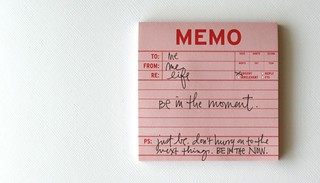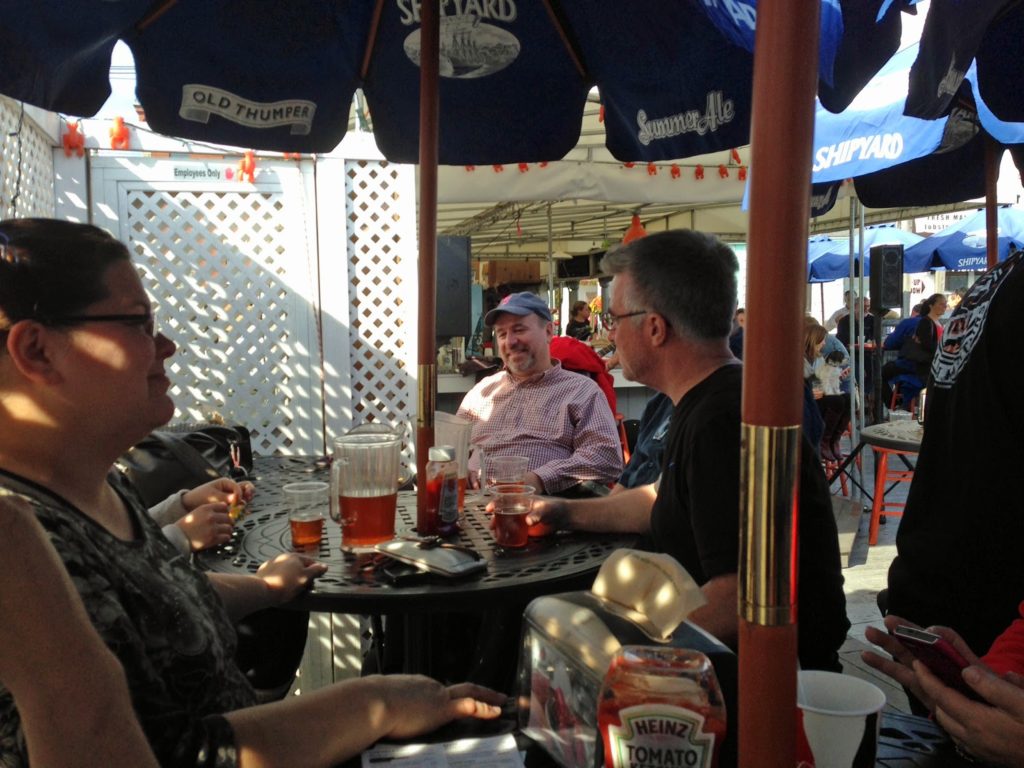| ali edwards |
My friend Andrew McLaughlin recently posted the following status on Facebook, after visiting our home town of Lincoln, Maine, during its homecoming celebration:
“While having lunch at the Knights of Columbus BBQ after Saturday’s parade, with Kimberly, I noticed a Lincoln icon sitting alone, in his motorized wheelchair, at the end of a table. He was struggling a bit while cutting up his chicken, so I decided to speak with him and offer some assistance. As I approached former Lincoln police officer Harold Woodard and introduced myself, he smiled and said that he remembered me. We talked at length… After a while I did manage to ask if I could help him by cutting up his chicken for him, not really knowing how a proud man like Harold might respond. He looked at me with caring eyes and said sincerely and with a little surprise, ‘I would really appreciate that’. It made my day to spend a few minutes with a local icon with such integrity and character. The world could use a few more Harold Woodards.”
I’m not acquainted with Mr. Woodard, but he seems like a first-class individual. This blog post, however, isn’t about him. It’s about wheelchair users in social situations, and how well Andrew handled it.
I am able to manage multiple conversations in the comfort of my home or across the table at a restaurant. But it’s so much more difficult at larger gatherings. Wheelchair users are simply unable to mingle nonchalantly like walking people do. The unwieldy piece of equipment we are attached to acts as a barrier – physically, socially, and psychologically. Space is often tight amongst the banquet tables, dance floors, and speaker’s podiums, etc. Therefore, it is preferable for us to remain somewhat stationary, and let the people work their way to us. It’s as if we are a receiving line of one. At least this is how we would like it to work. But more often than not the other socializers act as if they didn’t get the memo, which they probably didn’t.
Please consider this blog post as the memo.
What are the social and psychological reasons that people avoid approaching wheelchair users? I could spend a series of posts delving into this phenomena. Some reasons are: a fear of saying the wrong thing, a perception that wheelchair users are bitter and don’t want to socialize, uncertainty about whether to stand or sit when speaking to a wheelchair user, and fear that the wheelchair user will resent offers of help. Because of these and other barriers, many people are subconsciously disinclined to walk up to us, like Andy did with Mr. Woodard, to ask if we need any help and to strike up a conversation.
Mr. Woodard’s visit wasn’t the first time Andrew behaved admirably in this type of situation. Andrew and I were both attending a Fourth of July party this year at our friends Tim and Lynn’s house (Lynn, is it okay to call it Tim and Lynn’s house now?). In the normal comings and goings at a gathering with twenty people or so, some of whom know each other very well and others of whom are mere acquaintances, I found myself sitting alone for a moment. Andy sensed that and plopped himself on the barstool in front of me, asked me if I needed any help, and engaged me in conversation for ten minutes.
My momentary solitude at that party was not a big deal. It hadn’t gone on long enough that I felt lonely or conspicuous. But Andy took note of it, and took action. The next time you’re at a large gathering and there is a wheelchair user present, remember to treat the individual like a receiving line of one. But do more than shake hands and move along. Strike up a conversation. I guarantee you’ll both benefit from it.
“The world could use a few more Harold Woodards.” I don’t doubt that. But I would add this: the world could use a few more Andrew McLaughlin’s too.




Wonderful story Mitch! My Mom, who had been a shy kid, used to tell us how she handled that as an adult. If she was feeling alone in a group, she would look around and find another person who was alone and go talk to her. It takes a person who understands feeling alone to notice this sort of thing. Gregarious folks, often the center of attention, are often too busy talking to look around.
It's so true that we are hampered in moving around by the size of our equipment or perhaps even just by our cumbersome attempts to get up out of a chair and walk.
I was the gregarious one; oh how I wish I had done more looking around in the old days because, as you say, now that I sit in one place throughout an event, others are doing this for me and I can see firsthand, how much that means.
It's great to have such friends!
Great advice for the general public. If I could add one more thing… Don't stand behind a person’s wheelchair – it’s difficult for the wheelie to turn around. If you’re seated at a table, stand/sit next to the person. That way, the person isn’t talking to empty space.
Terrific post, Mitch. Sums up a very common problem/situation quite elegantly, and with a nice personal touch.
It is frustrating to suddenly find yourself a spectator rather than participant at communal gatherings. I must admit, though, that I sometimes enjoy just watching. The human zoo can be quite entertaining if you're in the right frame of mind… Other times you wind up feeling like a piece of furniture. Kudos to those who make the effort and realize that we are more than our wheelchairs
Daphne, your mom gave great advice. I was never that gregarious one anyway, so my transition to semi-wallflower was not that dramatic.
Muffie, excellent point. It's so hard for wheelchair users to see behind them. Not only do I notice it when people stand behind me, but I also notice it when people say "look at so-and-so" or "look at such and such" and I simply can't turn around enough to see.
Marc, you are right. It's not all bad, especially for an introvert like me. I enjoy people watching and my wheelchair affords me that opportunity during those occasions when I am out of the flow of a social gathering.
My son is in a chair which makes social events very difficult. To add to it, he is nonverbal and most of the time is totally ignored. People don't know what to do with him! But the other day at the family reunion my niece walked up to him and told him hi and mentioned how hot the weather was and just chit-chatted. As she started to leave I told her how appreciative I was that she took time to talk to him directly. Her simple, childlike answer was, "why wouldn't I? He's sitting right here."
Jeanie, your niece is an enlightened individual! Thanks for sharing.